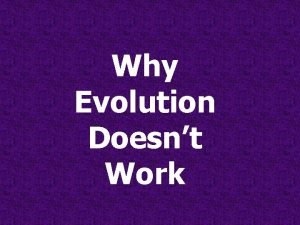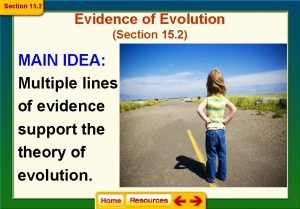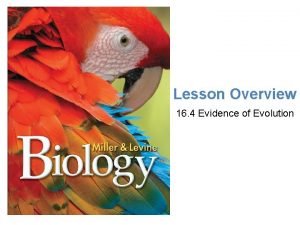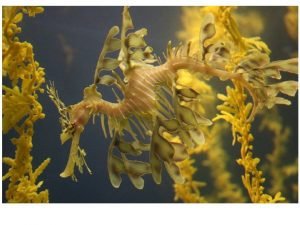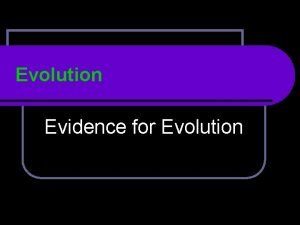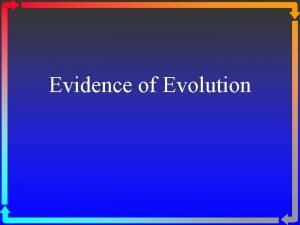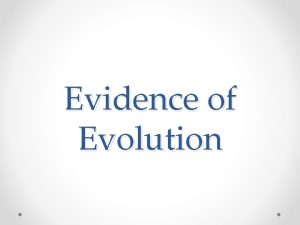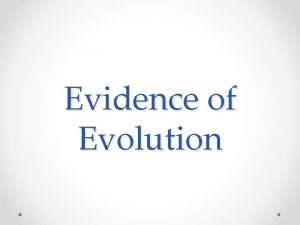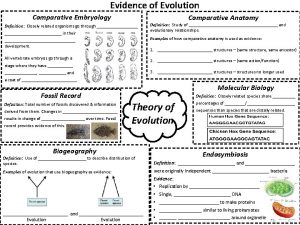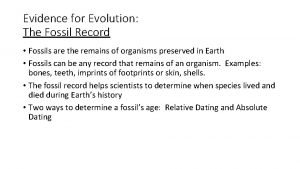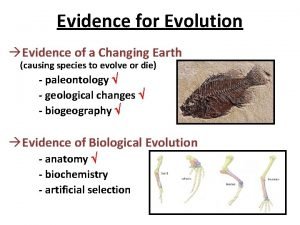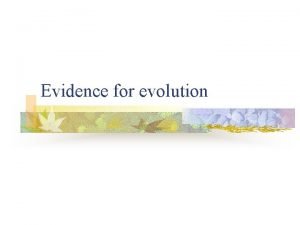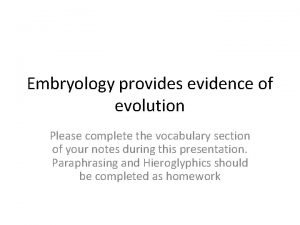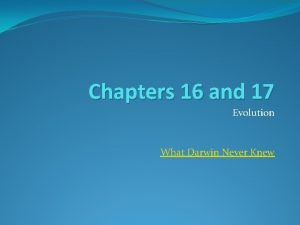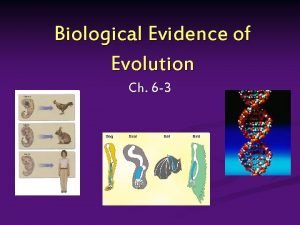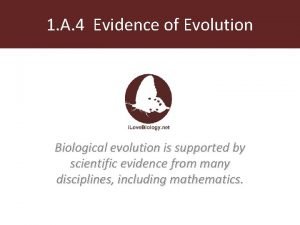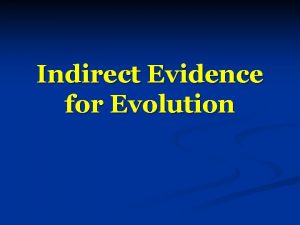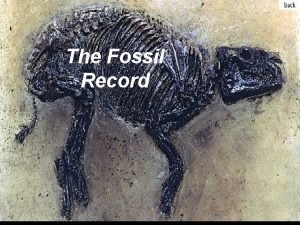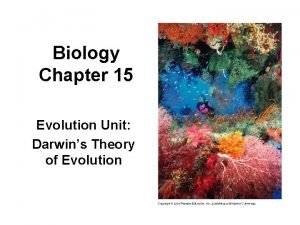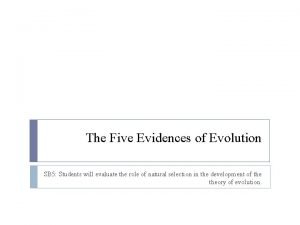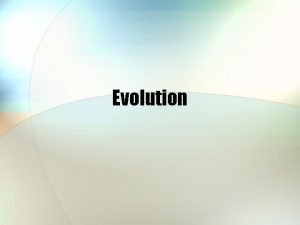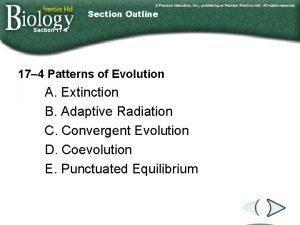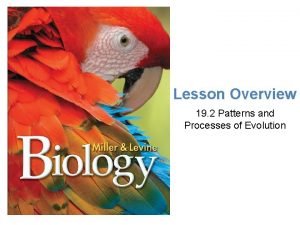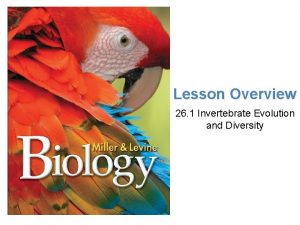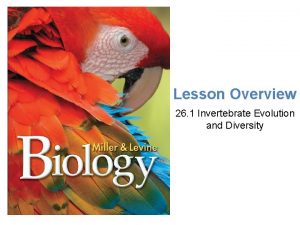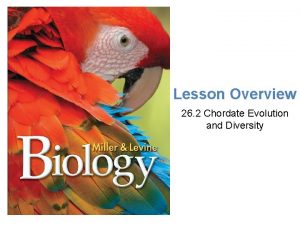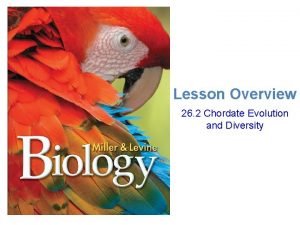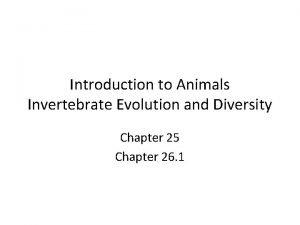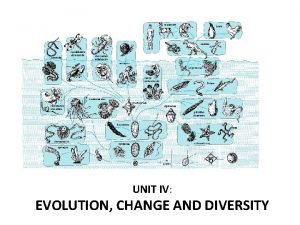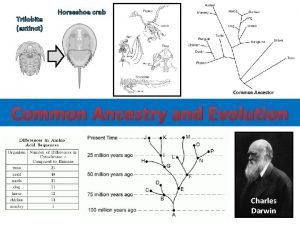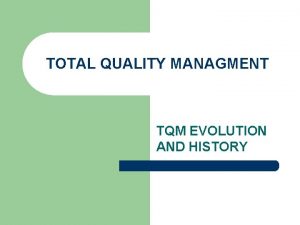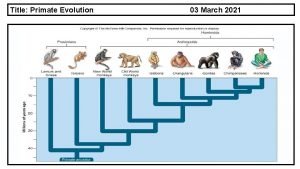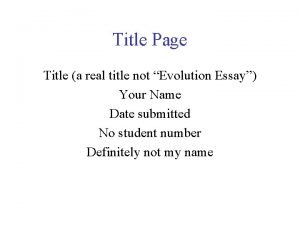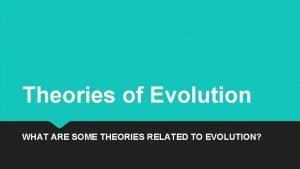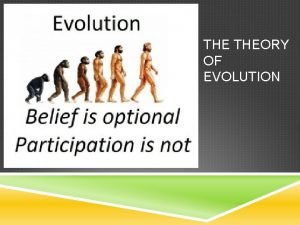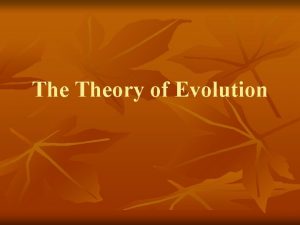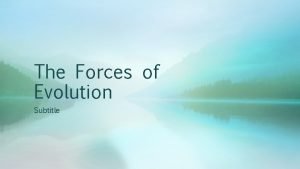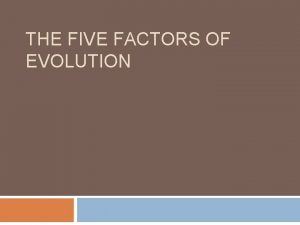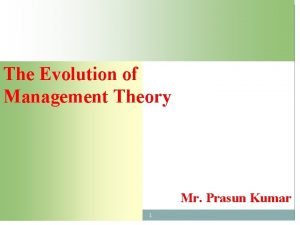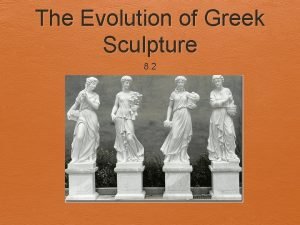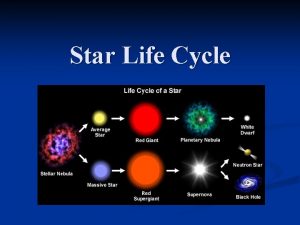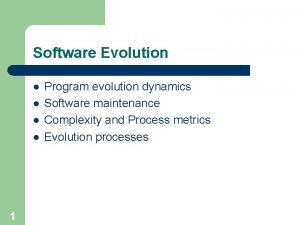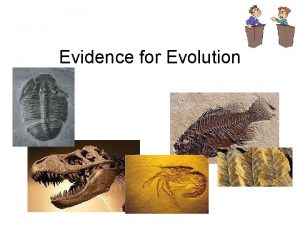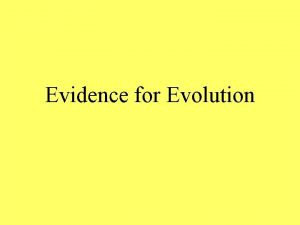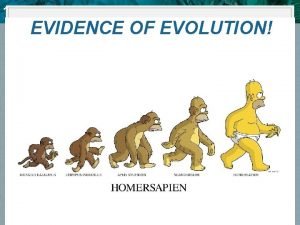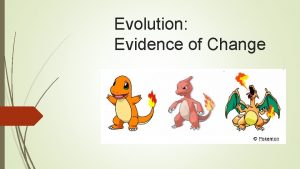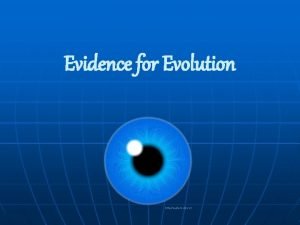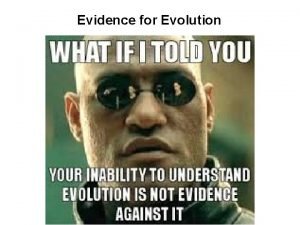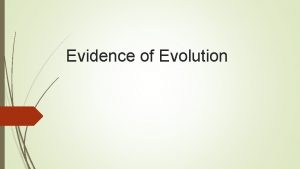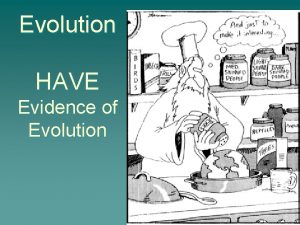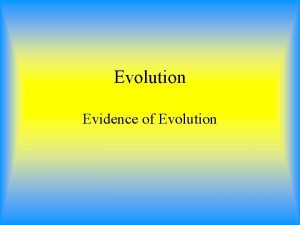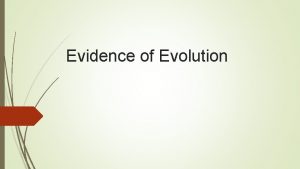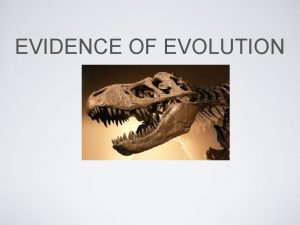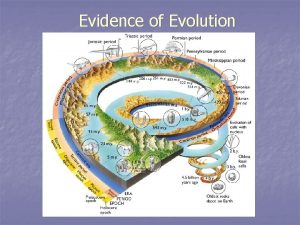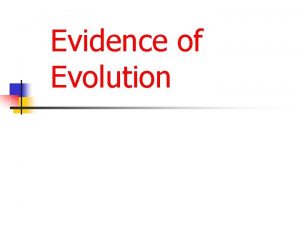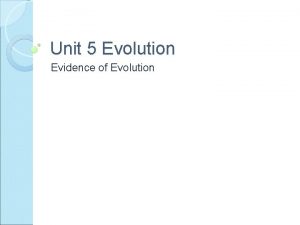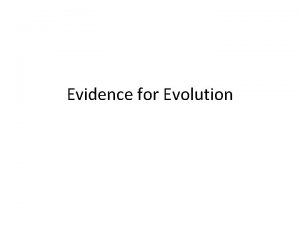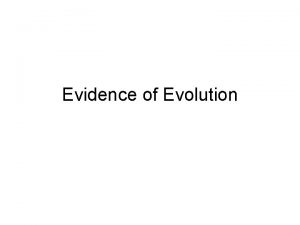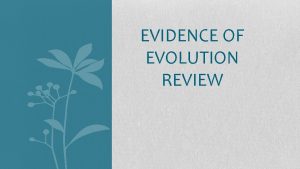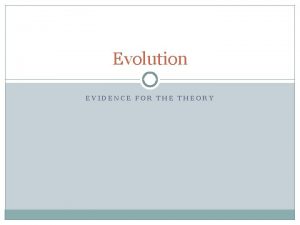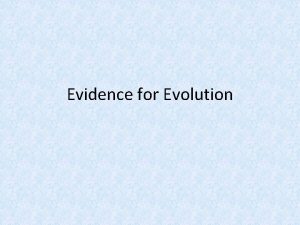Lesson Overview Evidence of Evolution Lesson Overview 16































































- Slides: 63

Lesson Overview Evidence of Evolution Lesson Overview 16. 4 Evidence of Evolution

Lesson Overview Evidence of Evolution THINK ABOUT IT Scientists in some fields, including geology, physics, paleontology, chemistry, and embryology, did not have the technology or understanding to test Darwin’s assumptions during his lifetime. And other fields, like genetics and molecular biology, didn’t exist yet! In the 150 years since Darwin published On the Origin of Species, discoveries in all these fields have served as independent tests that have supported Darwin’s basic ideas about evolution.

Lesson Overview Evidence of Evolution Biogeography How does the geographic distribution of species today relate to their evolutionary history? Patterns in the distribution of living and fossil species tell us how modern organisms evolved from their ancestors.

Lesson Overview Evidence of Evolution Biogeography is the study of where organisms live now and where they and their ancestors lived in the past. Two biogeographical patterns are significant to Darwin’s theory. 1. The first is a pattern in which closely related species differentiate in slightly different climates. 2. The second is a pattern in which very distantly related species develop similarities in similar environments.

Lesson Overview Evidence of Evolution Closely Related but Different To Darwin, the biogeography of Galápagos species suggested that populations on the island had evolved from mainland species. Over time, natural selection on the islands produced variations among populations that resulted in different, but closely related, island species. For example, natural selection produced variation in shell shape among the giant land tortoises that inhabit the islands.

Lesson Overview Evidence of Evolution Distantly Related but Similar On the other hand, similar habitats around the world are often home to animals and plants that are only distantly related. Rheas Emus Ostrich Darwin noted that similar ground-dwelling birds (rheas, ostriches, and emus) inhabit similar grasslands in Europe, Australia, and Africa. Differences in body structures among those animals provide evidence that they evolved from different ancestors. Similarities among those animals, however, provide evidence that similar selection pressures had caused distantly-related species to develop similar adaptations.

Lesson Overview Evidence of Evolution The Age of Earth and Fossils How do fossils help to document the descent of modern species from ancient ancestors? Many recently discovered fossils form series that trace the evolution of modern species from extinct ancestors.

Lesson Overview Evidence of Evolution The Age of Earth Evolution takes a long time. If life has evolved, then Earth must be very old. Hutton and Lyell argued that Earth was indeed very old, but technology in their day couldn’t determine just how old. Geologists now use radioactivity to establish the age of certain rocks and fossils. Radioactive dating indicates that Earth is about 4. 5 billion years old —plenty of time for evolution by natural selection to take place.

Lesson Overview Evidence of Evolution An Ancient, Changing Earth By Darwin’s time, the relatively new science of geology was providing evidence to support new and different ideas about Earth’s history. Geologists James Hutton and Charles Lyell formed important hypotheses based on the work of other researchers and on evidence they uncovered themselves. Hutton and Lyell concluded that Earth is extremely old and that the processes that changed Earth in the past are the same processes that operate in the present.

Lesson Overview Evidence of Evolution Hutton and Geological Change Hutton recognized the connections between a number of geological processes and geological features, like mountains, valleys, and layers of rock that seemed to be bent or folded. He realized, for example, that certain kinds of rocks are formed from molten lava.

Lesson Overview Evidence of Evolution Hutton and Geological Change Hutton also realized that some other kinds of rocks form very slowly, as sediments build up and are squeezed into layers. The rock layers in the Grand Canyon were laid down over millions of years and were then washed away by the river, forming a channel.

Lesson Overview Evidence of Evolution Hutton and Geological Change Hutton also proposed that forces beneath Earth’s surface can push rock layers upward, tilting or twisting them in the process and eventually forming mountain ranges. Mountains, in turn, can be worn down by rain, wind, heat, and cold. Since most of these processes operate very slowly, Hutton concluded that our planet must be much older than a few thousand years. Hutton introduced a concept called deep time—the idea that our planet’s history stretches back over a period of time so long that it is difficult for the human mind to imagine—to explain his reasoning.

Lesson Overview Evidence of Evolution Lyell’s Principles of Geology Lyell presented a way of thinking called uniformitarianism, the idea that the geological processes we see in action today must be the same ones that shaped Earth millions of years ago. Ancient volcanoes released lava and gases, just as volcanoes do now. Ancient rivers slowly dug channels and carved canyons in the past, just as they do today.

Lesson Overview Evidence of Evolution Lyell’s Principles of Geology Lyell’s theories, like those of Hutton, relied on there being enough time in Earth’s history for these changes to take place. Like Hutton, Lyell argued that Earth was much, much older than a few thousand years. Otherwise, how would a river have enough time to carve out a valley? This woodcut from Lyell’s Principles of Geology shows geological features near Italy’s Mount Etna. Among them is a deep channel, labeled “B, ” carved into a bed of lava.

Lesson Overview Evidence of Evolution Lyell’s Principles of Geology Lyell’s work helped Darwin appreciate the significance of an earthquake he witnessed in South America. The quake was so strong that it lifted a stretch of rocky shoreline more than 3 meters out of the sea—with mussels and other sea animals clinging to it. Sometime later, Darwin observed fossils of marine animals in mountains thousands of feet above sea level.

Lesson Overview Evidence of Evolution Lyell’s Principles of Geology Darwin realized that he had seen evidence that Lyell was correct! Geological events like the earthquake, repeated many times over many years, could build South America’s Andes Mountains—a few feet at a time. Rocks that had once been beneath the sea could be pushed up into mountains. Darwin asked himself, if Earth can change over time, could life change too?

Lesson Overview Evidence of Evolution by Natural Selection Under what conditions does natural selection occur? Natural selection occurs in any situation in which more individuals are born than can survive (the struggle for existence), there is natural heritable variation (variation and adaptation), and there is variable fitness among individuals (survival of the fittest).

Lesson Overview Evidence of Evolution The Struggle for Existence After reading Malthus, Darwin realized that if more individuals are produced than can survive, members of a population must compete to obtain food, living space, and other limited necessities of life. Darwin described this as the struggle for existence.

Lesson Overview Evidence of Evolution Variation and Adaptation Darwin knew that individuals have natural variations among their heritable traits, and he hypothesized that some of those variants are better suited to life in their environment than others. Any heritable characteristic that increases an organism’s ability to survive and reproduce in its environment is called an adaptation.

Lesson Overview Evidence of Evolution Variation and Adaptations can involve body parts or structures, like a tiger’s claws; colors, like those that make camouflage or mimicry possible; or physiological functions, like the way a plant carries out photosynthesis.

Lesson Overview Evidence of Evolution Survival of the Fittest According to Darwin, differences in adaptations affect an individual’s fitness. Fitness describes how well an organism can survive and reproduce in its environment. • Individuals with adaptations that are well-suited to their environment can survive and reproduce and are said to have high fitness. • Individuals with characteristics that are not well-suited to their environment either die without reproducing or leave few offspring and are said to have low fitness. This difference in rates of survival and reproduction is called survival of the fittest. In evolutionary terms, survival means reproducing and passing adaptations on to the next generation.

Lesson Overview Evidence of Evolution Natural Selection Darwin named his mechanism for evolution natural selection because of its similarities to artificial selection. Natural selection is the process by which organisms with variations most suited to their local environment survive and leave more offspring. In natural selection, the environment—not a farmer or animal breeder—influences fitness.

Lesson Overview Evidence of Evolution Natural Selection • Well-adapted individuals survive and reproduce. • From generation to generation, populations continue to change as they become better adapted, or as their environment changes. • Natural selection acts only on inherited traits because those are the only characteristics that parents can pass on to their offspring.

Lesson Overview Evidence of Evolution Natural Selection This hypothetical population of grasshoppers changes over time as a result of natural selection. Grasshoppers can lay more than 200 eggs at a time, but only a small fraction of these offspring survive to reproduce.

Lesson Overview Evidence of Evolution Natural Selection Certain variations, called adaptations, increase an individual’s chances of surviving and reproducing. In this population of grasshoppers, heritable variation includes yellow and green body color. Green color is an adaptation: The green grasshoppers blend into their environment and so are less visible to predators.

Lesson Overview Evidence of Evolution Natural Selection Because their color serves as a camouflage adaptation, green grasshoppers have higher fitness and so survive and reproduce more often than yellow grasshoppers do.

Lesson Overview Evidence of Evolution Natural Selection Green grasshoppers become more common than yellow grasshoppers in this population over time because more grasshoppers are born than can survive, individuals vary in color and color is a heritable trait, and green grasshoppers have higher fitness in this particular environment

Lesson Overview Evidence of Evolution Natural Selection Natural selection does not make organisms “better. ” Adaptations don’t have to be perfect—just good enough to enable an organism to pass its genes to the next generation. Natural selection also doesn’t move in a fixed direction. There is no one, perfect way of doing something. Natural selection is simply a process that enables organisms to survive and reproduce in a local environment.

Lesson Overview Evidence of Evolution Natural Selection For example, many different styles of pollination have evolved among flowering plants. Oak tree flowers are pollinated by wind. Apple tree flowers are pollinated by insects. Both kinds of pollination work well enough for these plants to survive and reproduce in their environments. OAK TREE APPLE TREE

Lesson Overview Evidence of Evolution Natural Selection If local environmental conditions change, some traits that were once adaptive may no longer be useful, and different traits may become adaptive. If environmental conditions change faster than a species can adapt to those changes, the species may become extinct.

Lesson Overview Evidence of Evolution Common Descent What does Darwin’s mechanism for evolution suggest about living and extinct species? According to the principle of common descent, all species—living and extinct—are descended from ancient common ancestors.

Lesson Overview Evidence of Evolution Common Descent Natural selection depends on the ability of organisms to reproduce and leave descendants. Every organism alive today is descended from parents who survived and reproduced. Just as well-adapted individuals in a species survive and reproduce, welladapted species survive over time. Darwin proposed that, over many generations, adaptation could cause successful species to evolve into new species. He also proposed that living species are descended, with modification, from common ancestors—an idea called descent with modification. According to the principle of common descent, all species—living and extinct—are descended from ancient common ancestors.

Lesson Overview Evidence of Evolution Common Descent This aspect of Darwin’s theory implies that life has been on Earth for a very long time—enough time for all this descent with modification to occur! Hutton and Lyell’s contribution to Darwin’s theory is that deep time gave enough time for natural selection to act. For evidence of descent with modification over long periods of time, Darwin pointed to the fossil record.

Lesson Overview Evidence of Evolution Common Descent Darwin based his explanation for the diversity of life on the idea that species change over time. This page from one of Darwin’s notebooks shows the first evolutionary tree ever drawn. This sketch shows Darwin’s explanation for how descent with modification could produce the diversity of life. A single “tree of life” links all living things.

Lesson Overview Evidence of Evolution Recent Fossil Finds Darwin’s study of fossils had convinced him and other scientists that life evolved, but paleontologists in 1859 hadn’t found enough fossils of intermediate forms of life to document the evolution of modern species from their ancestors. Since Darwin, paleontologists have discovered hundreds of fossils that document intermediate stages in the evolution of many different groups of modern species.

Lesson Overview Evidence of Evolution Recent Fossil Finds One recently discovered fossil series documents the evolution of whales from ancient land mammals. Several reconstructions based on fossil evidence are shown on the following slides. The exceptions to the reconstructions are the modern Mysticete and Odontocete.

Lesson Overview Evidence of Evolution Recent Fossil Finds

Lesson Overview Evidence of Evolution Recent Fossil Finds The limb structure of Ambulocetus (“walking whale”) suggests that these animals could both swim in shallow water and walk on land.

Lesson Overview Evidence of Evolution Recent Fossil Finds The hind limbs of Rodhocetus were short and probably not able to bear much weight. Paleontologists think that these animals spent most of their time in the water.

Lesson Overview Evidence of Evolution Recent Fossil Finds Basilosarus had a streamlined body and reduced hind limbs. These skeletal features suggest that Basilosarus spent its entire life swimming in the ocean.

Lesson Overview Evidence of Evolution Recent Fossil Finds Modern whales retain reduced pelvic bones and, in some cases, upper and lower limb bones. However, these structures no longer play a role in locomotion.

Lesson Overview Evidence of Evolution Recent Fossil Finds Other recent fossil finds connect the dots between dinosaurs and birds, and between fish and four-legged land animals. All historical records are incomplete, and the history of life is no exception. The evidence we do have, however, tells an unmistakable story of evolutionary change.

Lesson Overview Evidence of Evolution Comparing Anatomy and Embryology What do homologous structures and similarities in embryonic development suggest about the process of evolutionary change? Evolutionary theory explains the existence of homologous structures adapted to different purposes as the result of descent with modification from a common ancestor.

Lesson Overview Evidence of Evolution Comparing Anatomy and Embryology By Darwin’s time, scientists had noted that all vertebrate limbs had the same basic bone structure. For example, the front limbs of amphibians, reptiles, birds, and mammals contain the same basic bones.

Lesson Overview Evidence of Evolution Homologous Structures Darwin proposed that animals with similar structures evolved from a common ancestor with a basic version of that structure. Structures that are shared by related species and that have been inherited from a common ancestor are called homologous structures. Biologists test whether structures are homologous by studying anatomical details, the way structures develop in embryos, and the pattern in which they appeared over evolutionary history.

Lesson Overview Evidence of Evolution Homologous Structures Homologous bones, as shown by colorcoding, support the differently-shaped front limbs of modern vertebrates.

Lesson Overview Evidence of Evolution Homologous Structures These limbs evolved, with modifications, from the front limbs of a common ancestor whose bones resembled those of an ancient fish. Similarities and differences among homologous structures help determine how recently species shared a common ancestor. For example, the front limbs of reptiles and birds are more similar to each other than either is to the front limb of an amphibian or mammal. This similarity—among many others—indicates that the common ancestor of reptiles and birds lived more recently than the common ancestor of reptiles, birds, and mammals.

Lesson Overview Evidence of Evolution Homologous Structures Biologists have identified homologies in many other organisms. Certain groups of plants, for example, share homologous stems, roots, and flowers.

Lesson Overview Evidence of Evolution Analogous Structures The clue to common descent is common structure, not common function. A bird’s wing and a horse’s front limb have different functions but similar structures. Body parts that share a common function, but not structure, are called analogous structures. The wing of a bee and the wing of a bird are analogous structures.

Lesson Overview Evidence of Evolution Vestigial Structures Not all homologous structures have important functions. Vestigial structures are inherited from ancestors, but have lost much or all of their original function due to different selection pressures acting on the descendant. The hipbones of bottlenose dolphins are vestigial structures. In their ancestors, hipbones played a role in terrestrial locomotion. However, as the dolphin lineage adapted to life at sea, this function was lost.

Lesson Overview Evidence of Evolution Vestigial Structures The wings of a flightless cormorant and the legs of an Italian three-toed skink are vestigial structures.

Lesson Overview Evidence of Evolution Vestigial Structures Why would an organism possess structures with little or no function? One possibility is that the presence of a vestigial structure does not affect an organism’s fitness. In that case, natural selection would not eliminate it.

Lesson Overview Evidence of Evolution Embryology Researchers noticed a long time ago that the early developmental stages of many animals with backbones (called vertebrates) look very similar. Recent observations make clear that the same groups of embryonic cells develop in the same order and in similar patterns to produce many homologous tissues and organs in vertebrates. Similar patterns of embryological development provide further evidence that organisms have descended from a common ancestor.

Lesson Overview Evidence of Evolution Embryology Evolutionary theory offers the most logical explanation for these similarities in patterns of development. Similar patterns of embryological development provide further evidence that organisms have descended from a common ancestor.

Lesson Overview Evidence of Evolution Genetics and Molecular Biology How can molecular biology be used to trace the process of evolution? At the molecular level, the universal genetic code and homologous molecules provide evidence of common descent.

Lesson Overview Evidence of Evolution Genetics and Molecular Biology Darwin had no idea how heredity worked, and he was worried that this lack of knowledge might prove fatal to his theory. As it happens, some of the strongest evidence supporting evolutionary theory comes from genetics. A long series of discoveries, from Mendel to Watson and Crick to genomics, helps explain how evolution works. Also, we now understand how mutation and the reshuffling of genes during sexual reproduction produce the heritable variation on which natural selection operates.

Lesson Overview Evidence of Evolution Life’s Common Genetic Code All living cells use information coded in DNA and RNA to carry information from one generation to the next and to direct protein synthesis.

Lesson Overview Evidence of Evolution Life’s Common Genetic Code This genetic code is nearly identical in almost all organisms, including bacteria, yeasts, plants, fungi, and animals.

Lesson Overview Evidence of Evolution Life’s Common Genetic Code This compares a small portion of the DNA for the same gene in three animals —a mouse, a whale, and a chicken.

Lesson Overview Evidence of Evolution Life’s Common Genetic Code This similarity in genetic code is powerful evidence that all organisms evolved from common ancestors.

Lesson Overview Evidence of Evolution Homologous Molecules In Darwin’s day, biologists could only study similarities and differences in structures they could see. But physical body structures can’t be used to compare mice with yeasts or bacteria. Today, we know that homology is not limited to physical structures. Homologous proteins share extensive structural and chemical similarities. One homologous protein is cytochrome c, which functions in cellular respiration. Remarkably similar versions of cytochrome c are found in almost all living cells, from cells in baker’s yeast to cells in humans.

Lesson Overview Evidence of Evolution Homologous Molecules Genes can be homologous, too. One example is a set of genes that determine the identities of body parts. Know as Hox genes, they help to determine the head to tail axis in embryonic development. In vertebrates, sets of homologous Hox genes direct the growth of front and hind limbs. Small changes in these genes can produce dramatic changes in the structures they control.

Lesson Overview Evidence of Evolution Homologous Molecules Relatively minor changes in an organism’s genome can produce major changes in an organism’s structure and the structure of its descendants. At least some homologous Hox genes are found in almost all multicellular animals, from fruit flies to humans. For example, bacteria that live in a hot spring are very different from animals, yet many of their genes, and therefore the proteins coded by those genes, are similar to those of animals. Such profound biochemical similarities are best explained by Darwin’s conclusion: Living organisms evolved through descent with modification from a common ancestor.
 Evidence of evolution
Evidence of evolution Evidence for evolution doodle notes
Evidence for evolution doodle notes Evidence of evolution section 15-2 review
Evidence of evolution section 15-2 review Evidence for evolution
Evidence for evolution Convergent evolution definition
Convergent evolution definition Developmental homologies
Developmental homologies 4 types of evidence for evolution
4 types of evidence for evolution 4 types of evidence for evolution
4 types of evidence for evolution What are the four types of evidence for evolution
What are the four types of evidence for evolution Comparative embryology definition
Comparative embryology definition Examples of fossil evidence
Examples of fossil evidence Evidence of evolution stations answer key
Evidence of evolution stations answer key Lamarckian evolution
Lamarckian evolution Embryology evidence of evolution
Embryology evidence of evolution Example of evolution
Example of evolution Molecular biology evidence of evolution
Molecular biology evidence of evolution 6 evidences of evolution
6 evidences of evolution Evidence of evolution
Evidence of evolution Evidence for evolution
Evidence for evolution Indirect evidence of evolution
Indirect evidence of evolution Evidence of evolution of remnants and impressions *
Evidence of evolution of remnants and impressions * The fruit of evolution chapter 15
The fruit of evolution chapter 15 5 evidence of evolution
5 evidence of evolution Embryological evidence of evolution
Embryological evidence of evolution What is a primary source
What is a primary source Primary evidence vs secondary evidence
Primary evidence vs secondary evidence Secondary sources
Secondary sources Primary evidence vs secondary evidence
Primary evidence vs secondary evidence Primary evidence vs secondary evidence
Primary evidence vs secondary evidence Why are fibers class evidence
Why are fibers class evidence Class evidence vs individual evidence
Class evidence vs individual evidence Explain how class evidence may be useful
Explain how class evidence may be useful Class and individual evidence
Class and individual evidence Genetic fallacy definition
Genetic fallacy definition Structure and evolution of the universe. lesson 1
Structure and evolution of the universe. lesson 1 Section 17-4 patterns of evolution pages 435-440 answers
Section 17-4 patterns of evolution pages 435-440 answers Lesson 17 patterns and processes of evolution
Lesson 17 patterns and processes of evolution Invertebrates cladogram
Invertebrates cladogram What does the cladogram of invertebrates illustrate?
What does the cladogram of invertebrates illustrate? Lesson 6 chordate evolution and diversity
Lesson 6 chordate evolution and diversity Cladogram of chordates
Cladogram of chordates Cladogram of invertebrates
Cladogram of invertebrates Lesson 17 patterns and processes of evolution
Lesson 17 patterns and processes of evolution Chapter 9 lesson 2 photosynthesis an overview
Chapter 9 lesson 2 photosynthesis an overview Lesson overview
Lesson overview Lesson 90 solid evidence precipitation reactions
Lesson 90 solid evidence precipitation reactions Evolution of operating systems
Evolution of operating systems Convergent evolution
Convergent evolution Trilobite and horseshoe crab similarities
Trilobite and horseshoe crab similarities Tqm history
Tqm history Deming chain reaction
Deming chain reaction Primate evolution tree
Primate evolution tree Evolution title page
Evolution title page Lamarck's theory of evolution
Lamarck's theory of evolution Developmental homologies
Developmental homologies Divergent evolution examples
Divergent evolution examples 4 forces of evolution
4 forces of evolution Genetic drift
Genetic drift Evolution of management theory
Evolution of management theory Evolution of greek sculpture
Evolution of greek sculpture Evolution
Evolution Evolution and interpretation of computer architecture
Evolution and interpretation of computer architecture Stellar evolution diagram
Stellar evolution diagram Program evolution dynamics in software engineering
Program evolution dynamics in software engineering
